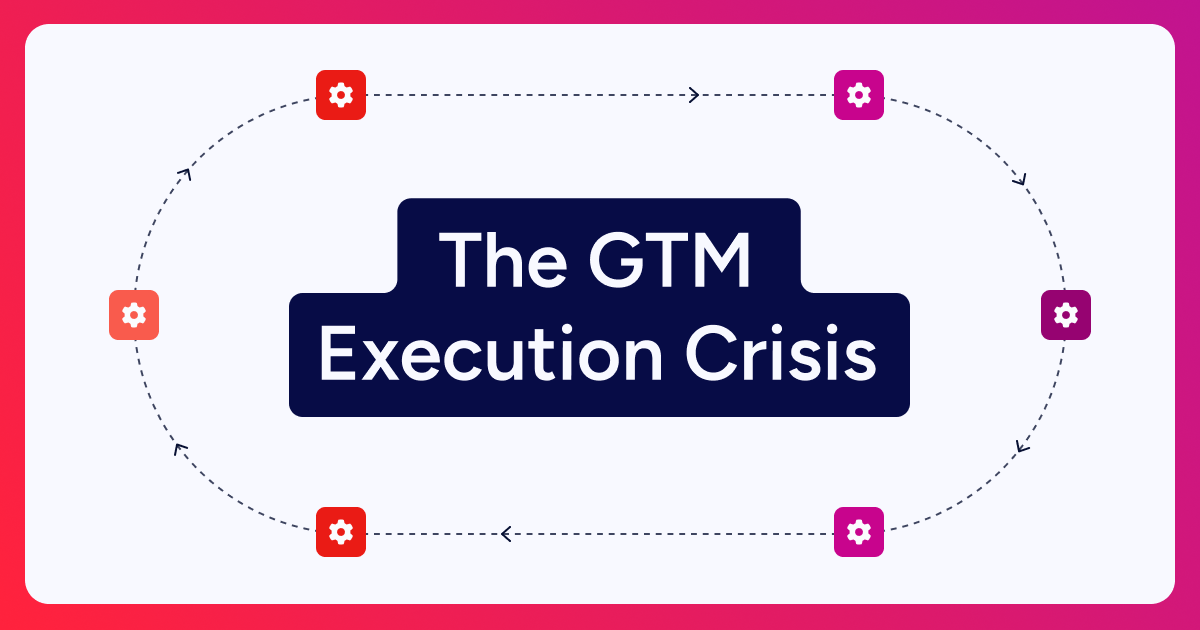We’ve all seen the vision of go-to-market AI that feels like magic.
Where every question has an instant answer, every signal turns into an action, and every rep executes with the power of your very best seller.
But right now, GTM doesn’t feel all that intelligent. It actually feels chaotic.
Reps drowning in tools. Marketers fighting for credibility. And CROs stuck in the middle.
At a conference last week, the founder of a fast-growing publicly traded software company was asked for his thoughts on AI in the sales role. His comments sum up our current state:
“It seems like in sales, while we thought it was the most ripe for AI disruption, what has actually happened is that we’ve cycled through a bunch of tools with AI promise that have not gone anywhere — we’re still not using any AI in our sales teams.”
Why hasn’t the vision of AI caught up with the reality of GTM? Because the systems we’re replacing weren’t built for this new reality.
As a founder and CEO, I’ve spent almost 20 years obsessing over one thing: execution. How to help leaders execute their strategies. How to help teams execute their playbooks. How to help sellers execute every deal. Smarter. Faster. More effective.
I think we’ve finally arrived at the inflection point that will fulfill the vision of AI. Here’s how to get there, and what we’re doing to fix it.
The Assembly Line We Built Is Broken
Over the last decade, GTM leaders became obsessed with predictable revenue.
We industrialized GTM into a machine capable of churning out repeatable motions. We tried to beat revenue into submission through standardization, optimization, and scale. We turned growth into an assembly line.
But while we were optimizing the machine, the buying environment kept changing. Buyers started tuning us out: doing their own research, showing up late in the process, and giving sellers just a sliver of their attention. Meanwhile, buying groups of one or two decision-makers swelled to as many as 10, multiplying the challenge for every seller in the room.
But our expectations didn't change. We still wanted higher conversion rates, faster pipeline velocity, the more growth.
The Impossible Job Description We Created
All of that pressure landed squarely on sellers. We expected them to be industry experts, market analysts, consultants, and strategists all at once. To walk into every meeting with a unique point of view not just on the industry or persona, but on this exact company and this exact buyer.
We wanted them to tailor decks, know every competitor, surface the right case study, speak fluently to the CRO, the CDO, and the VP of procurement, and build rapport with each individual in the room. Then repeat that level of preparation across 50 accounts at a time.
These expectations were literally impossible for every rep to deliver on. And I’ll admit, I was guilty of driving it too. Like many of you, I obsessed over every detail because every deal mattered. Together, we all created a job description no human seller could realistically fulfill.
The Tool Sprawl That Made Everything Worse
So what did we do to help? We bought tools for everything.
A tool for account planning. A tool for MEDDPICC. One for intent data, job postings, deal rooms. Every problem became a new subscription.
Your GTM team now navigates an average of 23 different tools just trying to do their jobs every day while straining under the weight of these impossible expectations. Reps open Outreach with 75 tasks and no prioritization. They bounce between Salesforce, SalesNav, intent tools, Excel docs, and ChatGPT. They spend 30 minutes building lists and rewriting messaging from scratch.
Then they hit send and hope something sticks. That’s not execution. It’s a shot in the dark.
The problem here isn't with the tools themselves, it's that none of them really talk to each other. Sure, you can stitch them together with a bunch of ad-hoc workflows. But without a shared foundation of data and buying signals — what we call GTM Intelligence — most systems are holding your sellers back from actually executing on your strategy.
The Vision: One Workspace That Actually Works
Now imagine what a seller’s day could look like when GTM finally has a system built for execution.
Instead of starting with 10 different tabs and a prayer, picture sellers beginning their day in one central workspace.
AI has already analyzed their entire book overnight. It knows which accounts are showing buying signals, which deals are at risk, which prospects engaged with which content, and exactly what action to take next.
Reps don't spend 30 minutes building lists. AI delivers prioritized moments based on real buyer readiness. They don't have to manually research accounts for hours. Intelligence is surfaced in context, exactly when and where they need it.
They don't write generic messages hoping something sticks. Personalized outreach is generated from real buyer signals and intent data. And they never need to update CRM again, as AI agents work behind the scenes to keep records current and accurate.
That vision exists, today, right now. It’s called GTM Workspace.
GTM Workspace is designed specifically for account executives and account managers, and brings together all the capabilities they need:
Create and execute outreach that is personalized, based on complete account context, using natural language commands.
Manage your book of business in one workspace, rather than bouncing between multiple tools and workflows.
Prepare for meetings instantly with unified account history, contacts, and activity, leading to stronger buyer confidence.
Monitor account and pipeline health to spot risks and identify expansion opportunities early, prioritizing on the opportunities that matter most.
Why Now Is Your Inflection Point
According to Boston Consulting Group, the inability to execute GTM strategies costs U.S. companies alone over $2 trillion annually. That's not a strategy problem or a tools problem. That's an execution problem.
The businesses implementing execution infrastructure today aren't just incrementally better. They're operating in a completely different league.
Every other part of your business already has a system built for how they work. IT has ServiceNow. Engineering has Atlassian. HR has Workday. Finance has NetSuite. But GTM, the half of your business that actually drives revenue, has been stuck with CRMs and point solutions that were never designed for execution.
That changes now. Because, in the end, execution is all that matters.
Learn how GTM Workspace turns strategy into action from day one. No training required, no engineering projects — just execution that works.


